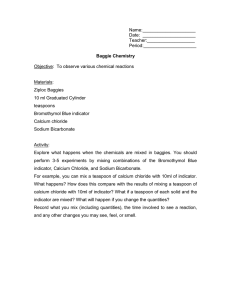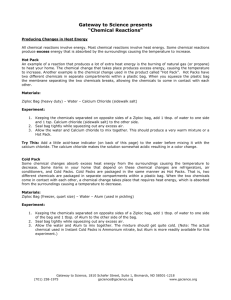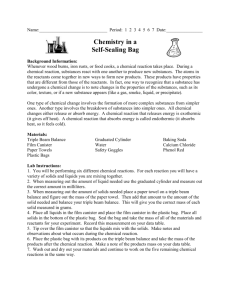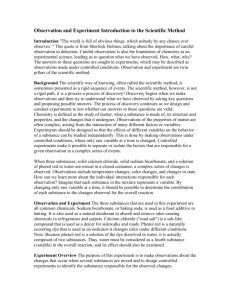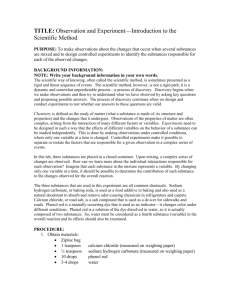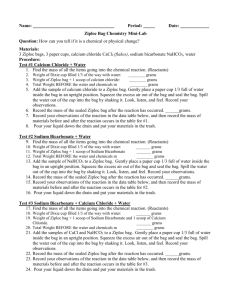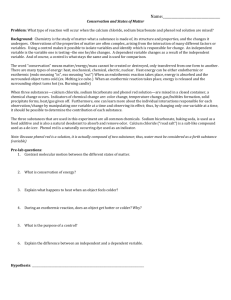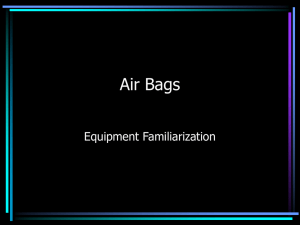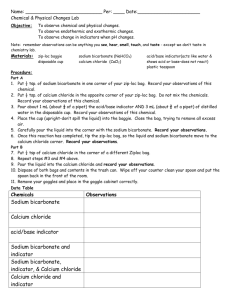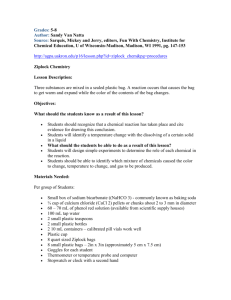crystal stinson lesson plan chemicals - esci300-2014
advertisement
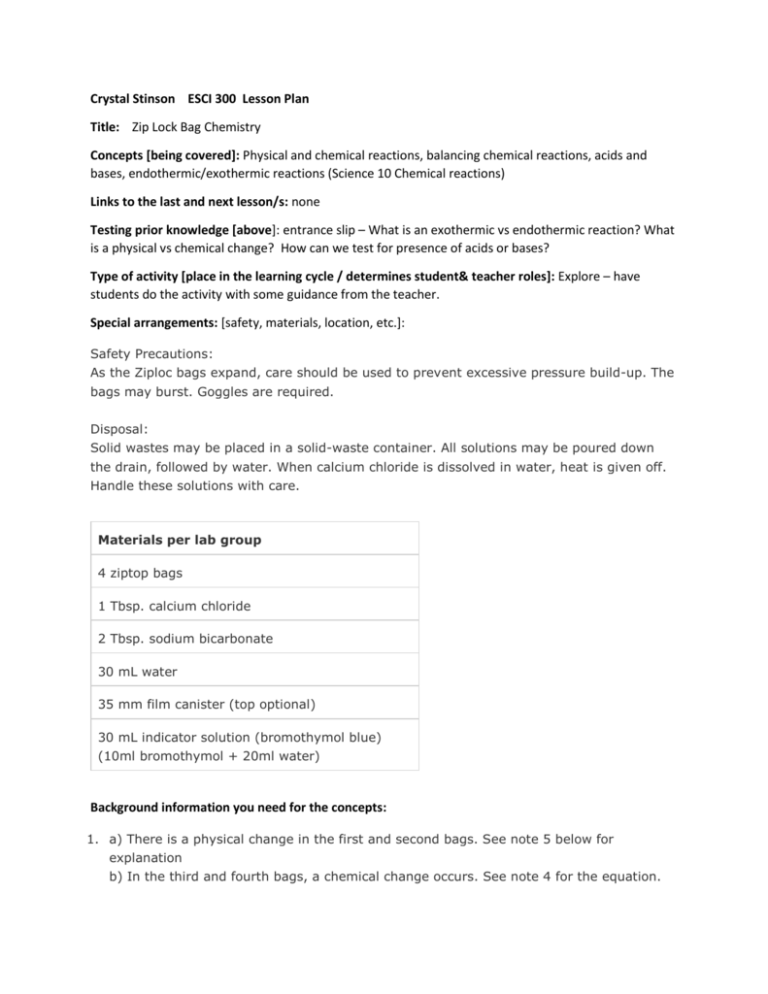
Crystal Stinson ESCI 300 Lesson Plan Title: Zip Lock Bag Chemistry Concepts [being covered]: Physical and chemical reactions, balancing chemical reactions, acids and bases, endothermic/exothermic reactions (Science 10 Chemical reactions) Links to the last and next lesson/s: none Testing prior knowledge [above]: entrance slip – What is an exothermic vs endothermic reaction? What is a physical vs chemical change? How can we test for presence of acids or bases? Type of activity [place in the learning cycle / determines student& teacher roles]: Explore – have students do the activity with some guidance from the teacher. Special arrangements: [safety, materials, location, etc.]: Safety Precautions: As the Ziploc bags expand, care should be used to prevent excessive pressure build-up. The bags may burst. Goggles are required. Disposal: Solid wastes may be placed in a solid-waste container. All solutions may be poured down the drain, followed by water. When calcium chloride is dissolved in water, heat is given off. Handle these solutions with care. Materials per lab group 4 ziptop bags 1 Tbsp. calcium chloride 2 Tbsp. sodium bicarbonate 30 mL water 35 mm film canister (top optional) 30 mL indicator solution (bromothymol blue) (10ml bromothymol + 20ml water) Background information you need for the concepts: 1. a) There is a physical change in the first and second bags. See note 5 below for explanation b) In the third and fourth bags, a chemical change occurs. See note 4 for the equation. 2. The indicator should show that the reaction occurring in the third bag is acidic. The bromothymol will turn from blue to yellow. 3. The gas that is produced is carbon dioxide, CO2. It is formed from the carbonate ion, HCO3 -. A burning splint would show that the gas extinguishes the flame. Some fire extinguishers use carbon dioxide for this reason. 4. The chemical changes that occur in bags 3 and 4 can be represented by the following equation: 2NaHCO3 (aq) + CaCl2 (aq)-> CaCO3 (aq) + 2NaCl (aq) + H2O (l) + CO2 (g) 5. A physical or chemical change may be accompanied by a change of energy. If the change requires heat from the environment, it is said to be endothermic. Solute + Solvent + HEAT ---> Solution If it releases energy to the environment, it is said to be exothermic. Solute + Solvent ----> Solution + HEAT 6. Many foods also contain indicators. One of these is red cabbage juice, which could be used in place of bromothymol. Script: how you see things unfolding [sequence of events] Have materials set out for students to use (ziplock bags, calcium chloride, sodium bicarbonate, indicator solution) on the front table. Have students’ select appropriate sized beakers from the supply cupboard and bring the materials they need to their work stations. Instruct students that they will need safety goggles. Students work in groups of 2-3, and follow the procedure below. They will need to fill in the data and observations and then answer the questions. Procedure 1. Add 2 Tbsp. sodium bicarbonate to a Ziploc™ bag. Gently place a film canister (approximately1/3 full of water) inside the bag in the upright position. Squeeze out any excess air and seal the bag. Spill the water into the bag by shaking. Look, listen, and feel. Record your observations. 2. Add 1 Tbsp. of calcium chloride to a second Ziploc™ bag. Repeat the remaining steps in procedure 1 for the calcium chloride, and record your observations for this material. 3. Mix 2 Tbsp. of sodium bicarbonate and 1 Tbsp. of calcium chloride in a third Ziploc™ bag and mix thoroughly. Repeat the remaining steps. 4. Repeat procedure 3, replacing the water in the film canister with 30mL of indicator solution. Data and Observations 1. sodium bicarbonate in water_________________________________ ________________________________________________________ 2. calcium chloride in water____________________________________ ________________________________________________________ 3. NaHCO3 + CaCl2 in water__________________________________ ________________________________________________________ 4. NaHCO3 + CaCl2 with indicator solution________________________________ ________________________________________________________ Questions 1. Classify each of these changes as chemical or physical. Use your observations to help you make your decisions. 2. In the fourth bag, what did the indicator tell you about the observed reaction? 3. What gas is being produced? How could you test this? 4. Write an equation for any chemical changes that have taken place. 5. Define heat of solution. Is it a physical change or a chemical change? Assessment of the learning: Have students discuss in small groups as they work through the questions. Have them hand-in their data/observations and answers to the questions. In the next lesson, we will be going on to the EXPLAINING portion of the learning cycle. Have students clean up, and put away any equipment they took out. First Five Minutes/ Last Five Minutes: The first 5 minutes will be the students answering the entrance slips. The last 5 minutes will be clean-up and discussion. Comments:
